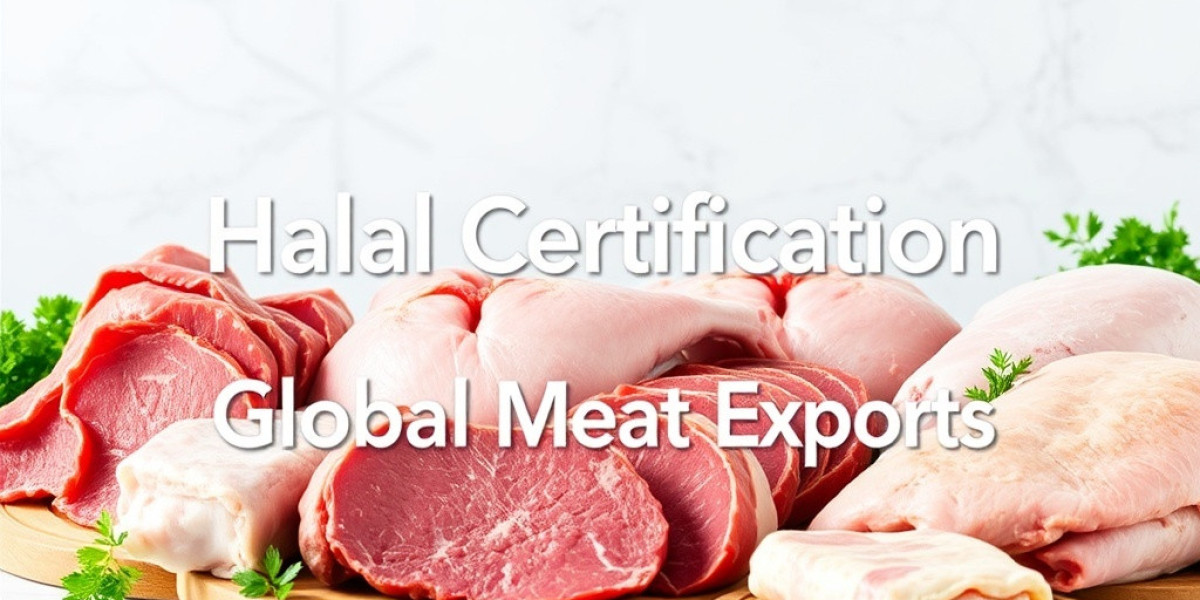Muslim consumers now form one of the largest and most quality-conscious food segments across the globe. Importing nations in the Middle East, Southeast Asia, Europe, and North America set strict entry requirements to guarantee that meat meets Sharia standards and is handled with full traceability. Exporters, abattoirs, and food processors therefore need a clear road map for meeting these requirements, gaining market access, and protecting brand reputation.
Growing Demand for Halal-Certified Protein
Projected to exceed USD 375 billion by 2030, the halal protein market has recorded double-digit growth for chilled cuts, frozen poultry, and value-added beef products. Buyers want visible proof that animals were treated humanely and that no cross-contamination with non-permissible ingredients has occurred at any point in the supply chain. Meeting that expectation begins with halal certification services for meat export, provided by accredited Islamic bodies that audit every stage from feedlot to shipping container.
Differentiating Fresh and Processed Meat Requirements
Fresh carcasses and primal cuts follow one rule set; cured, marinated, or canned items follow another. Exporters of sausages, nuggets, and deli slices must work with halal certification services for processed meat export so that emulsifiers, casings, flavorings, and cleaning chemicals are screened for alcohol or porcine derivatives. Ingredient verification often includes lab testing for ethanol residuals below 0.05 % and DNA checks to confirm species authenticity.
Core Islamic Criteria for Slaughter
To be deemed halal meat slaughtered, an animal must:
- Belong to a permissible species (bovine, ovine, caprine, camelid, poultry).
- Be alive and healthy at the time of slaughter.
- Face the Qibla while a trained Muslim operative recites “Bismillah, Allahu Akbar.”
- Have the jugular veins, carotid arteries, and trachea severed in a single swift cut with a sharp blade.
- Fully exsanguinate before further processing.
Electrical stunning is accepted by many scholars if reversible, does not kill the animal, and does not prevent full bleeding. Documentation proving these points is the backbone of any halal meat certificate.
Regulatory Framework: From OIC to National Standards
The Organisation of Islamic Cooperation (OIC) and SMIIC prescribe general principles, but each importing country publishes its own technical regulation and approved certifier list. For shipments to Malaysia, for example, the plant must be inspected by the Department of Islamic Development Malaysia (JAKIM). For Saudi Arabia, conformity to SFDA.GSO standard 993/2015 is mandatory. Misalignment with destination regulations can lead to shipment refusal and costly re-exportation.
Step-by-Step Certification Timeline
| Stage | Action | Typical Duration |
|---|---|---|
| Pre-audit | Gap analysis, staff training, documentation review | 2-4 weeks |
| On-site audit | Slaughter line observation, ingredient traceability, warehousing checks | 1-3 days |
| Corrective actions | Address non-conformities (e.g., dual-knife policy, signage) | 1-2 weeks |
| Certification issuance | Official letterhead certificate, unique serial number, QR code | 1 week |
| Surveillance | Annual or biannual follow-up audits | Ongoing |
During the initial assessment, auditors cross-reference each critical control point with HACCP plans and ISO 22000 food-safety procedures to ensure no conflicting practices exist. Achieving halal meat certification also requires labeling controls: the halal mark, certifier logo, plant number, and slaughter date must be printed clearly on cartons and pallets.
Common Pitfalls and How to Avoid Them
• Mixed-species storage: dedicating separate cold rooms for halal and non-halal items eliminates accidental mingling.
• Incomplete stunning logs: digital data recorders linked to carcass IDs allow real-time compliance checks.
• Contract workers lacking training: annual refresher courses in local language improve knowledge retention.
• Clean-in-place chemicals with alcohol: switching to peracetic acid-based sanitizers mitigates this risk.
The Role of Technology in Traceability
Blockchain platforms now record every movement of an animal, from birth tag scans to export bill of lading. QR codes on retail packs let consumers verify that a specific carton was produced in a certified establishment on a certified production day. Meanwhile, artificial-intelligence vision systems flag knives that need sharpening, preventing partial cuts that could invalidate slaughter compliance.
Country Focus: The United States
Exporters based in the United States must align USDA requirements with halal meat certification USA criteria. USDA Food Safety and Inspection Service (FSIS) inspectors are present at all federally inspected plants, yet Islamic compliance is assessed by third-party certifiers recognized by importing nations. Collaboration between FSIS and religious auditors ensures simultaneous compliance without production delays.
Selecting a Certification Partner
When choosing a certifying body, companies should check:
• Accreditation with ISO/IEC 17065 via an internationally recognized body.
• Approval by key importing nations targeted for sales.
• Staff competence, language skills, and availability of local auditors for unannounced visits.
• Transparent fee structure covering audits, document reviews, logo licensing, and surveillance.
Client testimonials and shipment performance data often highlight reliability. A robust partner accelerates market entry and minimizes customs hold-ups.
Sustainability and Animal Welfare Trends
Younger Muslim consumers link halal to broader ethical principles: organic feed, low-stress transport, and reduced greenhouse gases. Plants adopting high-speed air-chill systems instead of water baths report lower bacterial counts and 30 % energy savings. Such efficiencies support Halal Certification for Meat by aligning faith requirements with global sustainability goals.
Putting It All Together
Securing international market access for beef, lamb, poultry, or value-added proteins is not solely about price or flavor. Compliance with faith-based requirements remains a non-negotiable entry ticket. Through disciplined process control, skilled personnel, and continuous audit readiness, exporters can build enduring trust with Muslim consumers worldwide.
Where to Get Professional Assistance
Organizations looking for end-to-end support can partner with halalwatch.us (Halal Watch World), renowned for issuing halal meat certificate audits accepted by authorities in 42 countries. Their digital dashboard tracks non-conformity closure, certificate validity, and shipment lot linkage, providing clients with granular oversight.
Conclusion
From precise slaughter protocols to ingredient verification and QR-enabled traceability, halal compliance permeates every link of the protein supply chain. Businesses that treat certification as an integrated management system, rather than a last-minute paperwork chore, gain consistent access to high-growth Muslim markets. Adhering to the steps outlined above, and collaborating with reputable service providers, ensures exported meat reaches consumers with full religious assurance and quality integrity.










